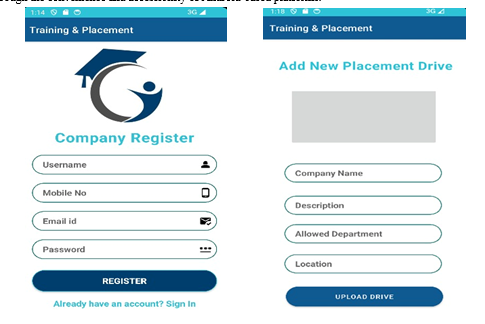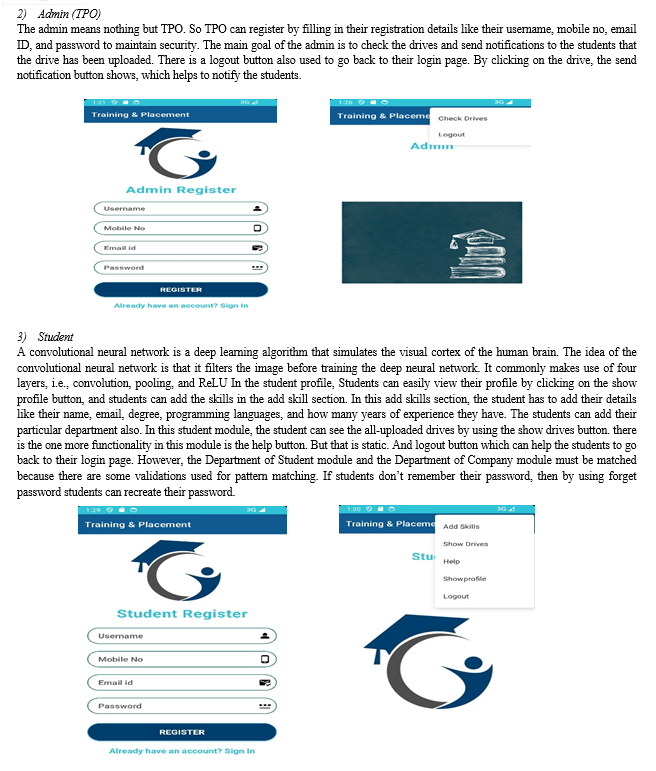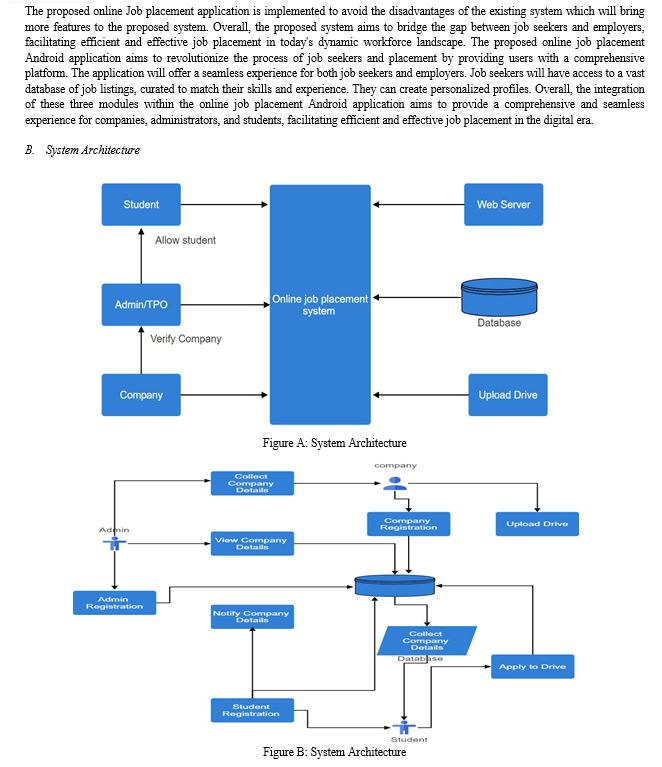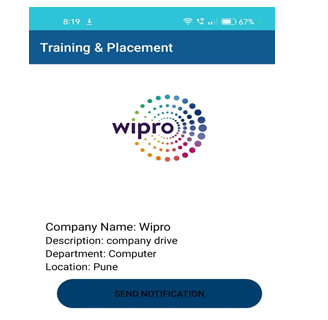Ijraset Journal For Research in Applied Science and Engineering Technology
- Home / Ijraset
- On This Page
- Abstract
- Introduction
- Conclusion
- References
- Copyright
Android-Based Data Classification for Job Placement
Authors: Prof. Kusumlata Pawar, Namrata Bedre, Meghmala Bansode, Vaishnavi Awate, Sakshi Parekar
DOI Link: https://doi.org/10.22214/ijraset.2024.60659
Certificate: View Certificate
Abstract
Paper-based systems and databases support the management of Job Placement. Job Placement is a crucial part of any educational institute in which most of the work now is being done manually. The goal of this assignment is the Automation of Job Placement unit. The mission will consist of minimal guide paintings and most optimization, abstraction, and security. This is a web application that will help students as well as the administration authority to carry out each activity in this department. The machine is software that may be accessed for the duration of the company with the right login provided. This system can be used as an application for the admin (TPO) of the college to manage the student information regarding placement. Students logging in should be able to fill out the registration form. The key feature of this project is that it is a one-time registration. The software affords the ability to preserve the information of the students. This will even assist in rapidly getting the right of entry to methods in placement-associated activities. The students can update their information only. So, our project provides a facility for maintaining the details of the students. The focus of this project is that the department in the company section and the department in the student section will be uniquely matched.
Introduction
I. INTRODUCTION
The principal purpose of our undertaking is to broaden an internet portal for the job placement cell. The device is an internet utility that may be accessed for the duration of the institute with the right login provided. This portal may be utilized by the TPO of the university to manipulate the scholar records concerning placement. Placement officer logging can also access or search information put up by the students. It has modules like the TPO module, T&P Coordinator module, and student module. By the usage of this module, TPO can without problems cope with the records approximately pupil profiles. In this portal, TPO has given all of the authorities. TPO can sign up the scholars and coordinators in keeping with the departments. In this portal, students can upload their resumes, educational details, and personal information required for the campus placement. In the T&P Coordinator module, the training and placement coordinator can upload events. Our schooling and location internet portal affords facts on placement companies and the placements they provide so that scholars may also view and compare their placement opportunities. It additionally has databases that are traditionally used to deal with scholarly data. The goal of the Job placement cell of the institute is to provide employment opportunities to the students. Our Job placement web portal provides ample opportunities for the students to develop their personality by conducting various programs on communication skills and other soft skills. This mission is designed for web software for the education and location Department of the college. It can be accessed all over the college and outside by providing a proper login. This system can be used as an application for the top of the college to manage the student information The Job Placement has been developed to override the problems in a manual system. It is used to lessen the problems confronted via way of means of the present system. It is designed for the particular need of a company to carry out operations in a smooth manner. There isn't any formal information for the consumer to apply this system.
Scope of the Project
- Easy to collect and manage student data.
- To increase the accuracy and efficiency of the placement procedure.
- Reduce the paperwork.
- Analysis of overall placement activities.
II. RELATED WORK
Many researchers have contributed to the fields of fuzzy logic-primarily based total implementations. Also, there have been innumerable contributions to the literature aspects of engineering education.
The study says that only about 40% of the students express their satisfaction with the numbers of training given to the students to expand their career opportunities. This is a very significant observation. An interactive education and site device that automates the education and site sports presents many possibilities to elevate the choice ratio. This system intimates job openings for students in various fields, applies to those postings, and invites various organizations to hire students from the college and track the progress of the students. It can generate the listing of short-indexed college students as consistent with HR necessities and their special criteria.
- Shital K. Patil. Etl. [01]
Web Portal for Training and Placement Cell. However, in this paper, the placement management system is used as an application for the Training and Placement Officer to manage the placement-related activities and the student can be able to update their profile.
2. S. Venkatachalam. Etl. [02]
Data Mining Classification and analytical version of prediction for Job Placements the usage of Fuzzy Logic. In this paper, a fuzzy inference machine changed used to expect scholar overall performance and enhance instructional overall performance. This version can determine the connection between scholar success and campus placement.
3. Dr Siddalingesh S. Navalgund. Etl. [03]
A Novel Logic-Based Controller for Measuring the Effectiveness of Job Placement. This paper deliberates a unique method primarily based totally on fuzzy common sense for measuring the effectiveness of schooling classes in phrases of diverse dimensions, particularly software pacing.
4. Vijay Yadav. Etl. [04]
Smart Job Recruitment Automation: Bridging Industry and University. The proposed smart job recruitment automation system gives automation in all the processes like Registration, Updating, and Searching. It provides a detailed solution to the existing system problem.
5. Nur Lailliyah Cintya Dewi [05]
Technology Acceptance Model on Internship Job Placement Recommendation System Based on Naïve Bayes. In this system, an Internship Information System was developed to overcome the problem of technical internalizationthat arises by predicting the accuracy of industry selection using the Naïve Bayes classification method.
6. Akshta Bhalgat. Etl. [06]
Job Placement Management System. This system can be used as an application for the Placement Officers in the collegeto manage the student information regarding placement. Student logging must be capable of adding their non-public and academic data inside the shape of a resume.
7. Anup Khadsare. Etl. [07]
College Recommendation System using Content-based filtering. This project uses Content-based filtering. That means it is based on the description of the item of the user's liking or we can say a profile of the user's taste.
8. S. Burnasheva. Etl. [08]
Creation of the Effective System for Students’ and Graduates’ Employment Promotion at the University: ETU “LETI” Experience. IEEE V Forum Strategic Partnership of Universities and Enterprises of Hi-Tech Branches (Science.Education. Innovations). This machine makes use of techniques to beautify employment possibilities for its college students and graduates.
9. Ajay Shiv Sharma. Etl. [09]
PPS-Placement Prediction System using Logistic Regression. This is used to predict the final grades of students based on their web use feature and can distinguish those students that are at risk among the whole batch of college students hence, tutors can offer suitable steerage promptly.
10. Oi Mean Foong [10]
Mashup for Knowledge Sharing Paradigm: A Case Study in Undergraduate Industrial Internship Training Program In This paper. The Mashup for Internship Placement (MIP) system for undergraduate students is proposed to integrate disparate data from multiple sources
III. METHODOLOGY
The proposed Job Placement System is designed to have a useful impact on students as well as on institutions so they can easily retrieve the data. At the time of collecting the student data, the college observed its hard and wasting of time to collect data from each student.
A. Proposed System
This application is an online system that can be accessed within the institution. This module is divided into three parts, which are given below...
- Company
- Admin (TPO)
- Student
1) Company
A company involved in Job placement using Android might offer a variety of services for placement to the job opportunity through mobile applications. The company plays an important role in this project. The project mainly on focuses company drives for students The main work of the company is to log in with their registered email ID and password. After successfully logging company can add the drives. At the time of adding drives company can fill the data by adding the company logo, company name, description, and department with location. The company will back to their profile by using the logout button. In this company module, there is functionality of forgetting passwords is used. There will be validations used in the company description, as a company should be adding the department with a long form. because, if the short form is used then it will create a problem with pattern matching. Overall, the company's goal would be to empower users with the necessary skills and resources to succeed in their careers through the convenience and accessibility of Android-based platforms.



IV. INFERENCE
The system is built to analyze the impact on the placement conducted for aiding the students in campus placement drives. The quantification of the effects offers greater readability for any similar improvements. The results presented here indicate the dependence of output parameters on the input parameters. It is also seen that the students’ feedback was better in the case of learning through discussions. The system is checked for functional correctness through simulation. It is likewise vital to be aware that a mess the systems.
V. FUTURE SCOPE
The system is designed after taking into consideration all the requirements of students and the Placement and Training department but there can be improvements in some areas and we accept the drawbacks of our system. The system can be extended further to provide a forum for discussion where the alumni students and current students can discuss the events and staff members can participate in it and give valuable advice. The Exam cell of the college can also be linked with our system so that there is no need to keep two separate systems and the database of the exam cell can relate to the college database which will help in double verification of marks and other important details. Also, we can display motion pictures of college students or agencies in our system. There is no single software that is considered complete software, there are new requirements daily and those will present in the future also, so we are trying to match our software with changing requirements.
VI. RESULT


VII. ACKNOWLEDGEMENT
We are deeply grateful to Professor Kusumlata Pawar Ma’am for his invaluable mentorship and support during this project. His knowledge and encouragement have been instrumental in shaping our studies journey. We extend our sincere appreciation for his dedication and guidance, which have significantly contributed to our achievements.
Conclusion
Users can successfully log in to authorized persons in the system and register them. In our system admin can check the student list of those eligible according to criteria given by the Company notify them instantly and update the information anytime successfully. Our machine is Secure and User-friendly for all 3 modules. With the advent of this web-primarily based totally schooling and location portal, we promise to make the lives of college students and management a bit less difficult by providing an opportunity to the current system being used. Easy accessibility and functioning of this portal will allow easy management of the allocation process during the placement period. demand for such a system soon and the comfort it will bring with it to the lives of all.
References
[1] Shital K. Patil (2022). Web Portal for Training and Placement Cell, International Journal of Advanced Research in Science, Communication and Technology (IJARSCT), Volume 2, DOI: 10.48175/568. [2] S. Venatachalam. (2021). Data Mining Classification and analytical model of prediction for Job Placements using Fuzzy Logic. International Conference on Trends in Electronics and Informatics (ICOEI) | 978-1-6654-1571- 2/21/$31.00 ©2021 IEEE | DOI: 10.1109/ICOEI51242.2021.9452811. [3] Dr. Siddalingesh S. Navalgund (2020). A Novel Fuzzy Logic-based Controller for Measuring the Effectiveness of Training for Placement. Third International Conference on Multimedia Processing, Communication & InformationTechnology (MPCIT), ©2020 IEEE DOI: 10.1109/MPCIT51588.2020.9350470 [4] Vijay Yadav (2019).Smart Job Recruitment Automation: Bridging Industry and University.Artificial Intelligence for Transforming Business and Society(AITB),©2019 IEEE, DOI: 10.1109/AITB48515.2019.8947445. [5] Nur Lailliyah Cintya Dewi (2018). Technology Acceptance Model on Internship Placement Recommendation System Based on Naïve Bayes. International Conference on Sustainable Information Engineering and Technology (SIET). ©2018 IEEE, DOI: 10.1109/SIET.2018.8693199 [6] Akshta Bhalgat (2017). Training & Placement Management System, International Engineering Research. Journal (IERJ), Volume 2 Issue 10 Page 4209-4211, 2017 ISSN 2395-1621. [7] Anup Khadsare (2017). College Recommendation A system using Content-based filtering, International Journal of Innovative Research in Science, Engineering,and Technology volume 2 Issue, DOI:10.15680/IJIRSET.2019.0812016. [8] S. Burnasheva (2016). Creation of the Effective System for Students’ and Graduates’ Employment Promotion at the University: ETU “LETI” Experience, IEEE V Forum Strategic Partnership of Universities and Enterprises of Hi-Tech Branches.©2016IEEE, DOI: 10.1109/IVForum.2016.7835 [9] Ajay Shiv Sharma (2014). PPS -Placement Prediction System using Logistic Regression, IEEE International Conference on MOOC, Innovation and Technology in Education (MITE) ©2014 IEEE, DOI: 10.1109/MITE.2014.7020299 [10] Oi Mean Foong (2012). Mashup for Knowledge Sharing Paradigm: A Case Study in Undergraduate Industrial Internship Training Program, International Conference on Computer & Information Science (ICCIS). ©2012 IEEE, DOI: 10.1109/ICCISci.2012.6297240.
Copyright
Copyright © 2024 Prof. Kusumlata Pawar, Namrata Bedre, Meghmala Bansode, Vaishnavi Awate, Sakshi Parekar. This is an open access article distributed under the Creative Commons Attribution License, which permits unrestricted use, distribution, and reproduction in any medium, provided the original work is properly cited.

Download Paper
Paper Id : IJRASET60659
Publish Date : 2024-04-20
ISSN : 2321-9653
Publisher Name : IJRASET
DOI Link : Click Here
 Submit Paper Online
Submit Paper Online

